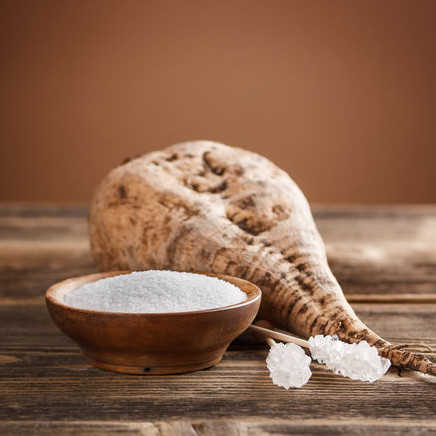
Beet Sugar
Also known as Beta vulgaris
What is Beet Sugar?
Beet sugar is the sugar by-product extracted from the sugar beet (Beta vulgaris) and is a common sucrose source used in commercial baking, in the form of granulated, powdered, and brown sugars. These varieties are created during processing through adjustments in:
- Crystallization
- Drying
- The addition of molasses
Sugar selection is determined by the desired end product since different sugar sizes may play a role in baked goods’ appearance or taste. Some refining by-products may be used as an ingredient to add fiber content to prepared foods such as cereals.
Origin
Sugar beets are grown in throughout North America. All sugar from beets are GMO, unless otherwise stated.1 Unlike sugar cane, beet sugar is refined in a single processing facility. Most non-sugar by-products from refining are re-used or recycled. Some of these by-products may be used as ingredients in commercial foods. The beet pulp, for example, is commonly used for animal feed.2
The sugar beets’s origins can be traced to a beet species used for fodder across German Silesia. Sugar was first extracted from the root in 1747. The Napoleonic wars stimulated further research into genetics and the refining process since cane sugar shipments to the continent were blocked by British troops.3
The first commercial refining facility in the United States opened in 1879. There were 91 factories in 18 states by 1917. Today, of the roughly 4.5 million tons of sugar produced annually in the United States, about 54 percent is beet sugar U.S.3,4
During processing, beets are first washed, shredded, and sent through a diffuser. A combination of hot water and pressure forces the sugar out of the beet shreds. The resulting liquid is purified and evaporated to produce an extremely viscous sugar syrup, which undergoes crystallization to produce the sugar granules. The remaining “mother” liquid may be concentrated and crystallized again. A series of subsequent processes further clarify the compound before one final crystallization process is used to create pure, white sugar. Sugar crystal sizes can be changed during the boiling process; in fact, a variety of granule sizes are desired by commercial producers to meet specific baking requirements.5,6
There are three or four different grades of sugar. The top tier sugar is roughly 99 percent pure sucrose. The third and fourth grades contain some impurities and will typically be yellow or dark. These are also known as partially-refined sugar.6
Function
Despite anecdotes to the contrary, “it is impossible to tell whether [sugar] is derived from sugar cane or sugar beets,” according to Bakery Products: Science and Technology.6
Although best known as a sweetener, sugar—regardless of its plant origin—is an ingredient with many functional properties. When used in breads, as well as in whole grain breads and cereals, sugar may contribute to product flavor as well as its bulk, texture/mouthfeel, shelf life, fermentation, color, and moisture retention. Some of these same functions are why sugar is used as an ingredient in bakery products and other prepared foods.7
Nutrition
Sugar’s nutritional value—not simply that of beet-derived sugars—is the object of much debate and research surrounding the health concerns associated with consumption, and overconsumption in particular. Public health officials say reduced sugar intake would help reduce disease risk, including obesity and tooth decay.
WHO says these guidelines are designed to be used with other nutrition and dietary guidelines; however, some of the resultant policy issues may result in national public health officials working with food manufacturers to reduce the amount of free sugar in processed foods.8
Commercial production
Many manufacturers utilize beet sugar when a granulated sugar variety is required due to its wide availability.
Application
Sucrose is sugar. There is no difference between beet sugar and cane sugar. Both are disaccharides consisting of one fructose molecule and one glucose molecule bonded together.6
A wide selection of sugars are available to the commercial baker. These include various sizes of granulated sugar as well as Baker’s special sugar, powdered sugar, fondant and icing sugar; and baker’s divert sugar. The latter have some of the finest granules available.6 Its use in bread is usually 3-5% on flour weight. In cakes and other applications, it can go higher than 50% on flour weight.
Beyond its utility as a sweetener, sugar beet pulp is the basis of additives typically used to provide commercial food products, breakfast cereals among them, with a high dietary fiber content.9
References
- Charles, Dan. “As Big Candy Ditches GMOs, Sugar Beet Farmers Hit A Sour Patch.” NPR, NPR, 12 May 2016, www.npr.org/sections/thesalt/2016/05/12/477793556/as-big-candy-ditches-gmos-sugar-beet-farmers-hit-sour-patch. Last accessed 22 October 2018.
- “Refining & Processing.” The Sugar Association, www.sugar.org/sugar/refining-processing/. Last accessed 15 October. 2018.
- “Sugarbeet History.” American Sugarbeet Growers Association, americansugarbeet.org/who-we-are/sugarbeet-history/. Last accessed 15 October 2018.
- “Background.” USDA ERS – Background, www.ers.usda.gov/topics/crops/sugar-sweeteners/background.aspx#production. Last accessed 15 October 2018.
- “Types of Sugar.” The Sugar Association, www.sugar.org/sugar/types/. Last accessed 15 October 2018.
- Hui, Y. H., editor. Bakery Products: Science and Technology. John Wiley & Sons, 2008. Pages 30-31, 138-140. (Via Google Scholar.)
- “Sugar’s Role in Food.” The Sugar Association, www.sugar.org/diet/role-in-food/. Last accessed 15 October 2018.
- “WHO Calls on Countries to Reduce Sugars Intake among Adults and Children.” World Health Organization, World Health Organization, 17 May 2016, www.who.int/mediacentre/news/releases/2015/sugar-guideline/en/. Last accessed 12 October 2018.
- Sugarbeets, hort.purdue.edu/newcrop/afcm/sugarbeet.html. Last accessed 15 October 2018.

